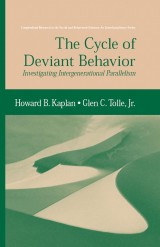Details

The Cycle of Deviant Behavior
Investigating Intergenerational ParallelismLongitudinal Research in the Social and Behavioral Sciences: An Interdisciplinary Series
|
96,29 € |
|
| Verlag: | Springer |
| Format: | |
| Veröffentl.: | 24.11.2006 |
| ISBN/EAN: | 9780387326443 |
| Sprache: | englisch |
| Anzahl Seiten: | 238 |
Dieses eBook enthält ein Wasserzeichen.
Beschreibungen
This volume is about understanding the relationship between deviance and selected correlates of deviance in one generation and deviance and its selected correlates in the next generation. By examining the significance of these constructs in the parental generation as part of the explanation for the same constructs in the child’s generation, we contribute to an und- standing of the phenomena. This contribution, however, is quite limited in the sense that we are examining in essence bivariate relationships—the association between first-generation and second-generation phenomena— while ignoring all of the other influences on the second-generation p- nomena that do not stem from or account for the intergenerational relationship. Nevertheless, the study of intergenerational parallelism of deviance and its correlates justifiably has excited attention and resulted in a vo- minous literature greater than might have been expected for any parti- lar bivariate relationships because of the mystique surrounding ideas—cycle of violence, reproduction of culture, to name but a few—that are evoked by consideration of the association between such phenomena in one generation and the same phenomena in a successive generation.
Theoretical and Methodological Issues in the Study of Intergenerational Parallelism of Deviance.- Toward an Understanding of Intergenerational Parallelism of Deviance.- Method.- The Conditional Nature of Intergenerational Parallelism.- Observing Intergenerational Parallelism in Deviance.- Moderators of Intergenerational Parallelism.- Decomposing Intergenerational Parallelism.- Intervening Processes.- Intergenerational Continuity of Intragenerational Causes of Deviant Behavior and Its Correlates.- Retrospect and Prospect.- Summary and Conclusions.
<P>To conduct the study on criminal and antisocial behavior at the center of this volume, the authors devoted years to collecting data from a large community sample of first-generation subjects. Data were garnered throughout their early adolescence, twenties, and thirties as well as from these first-generation subjects’ biological children during their own early adolescence. The results of these studies have profound implications for future research and methodology on deviant behavior.</P>
<P></P>
<P>Within the succinct, information-packed seven chapters of <EM>The Cycle of Deviant Behavior: Investigating Intergenerational Parallelism</EM>, the authors:</P>
<P></P>
<UL>
<P></P>
<LI>Present an integrative theory of deviant behavior, synthesizing social stress, social control, societal labeling, and other perspectives.</LI>
<LI>Describe the intergenerational cycle of deviant behavior.</LI>
<LI>Identify the relationship between deviance and its significant correlates (e.g., self-rejection).</LI>
<LI>Explain factors central to motivation toward deviant behaviors and to the continuance or discontinuance of these behaviors across generations.</LI>
<LI>Review the literature on intergenerational parallelism and discuss the methodological limitations of current studies.</LI>
<P></P></UL>
<P></P>
<P>By providing multiple models of parental transmission of values and culture – and acknowledging the roles of intervening processes in life – <EM>The Cycle of Deviant Behavior: Investigating Intergenerational Parallelism</EM> offers well-rounded insights to a wide range of professional readers, including sociologists, criminologists, and specialists in developmental and abnormal psychology and psychiatry.</P>
<P></P>
<P>Within the succinct, information-packed seven chapters of <EM>The Cycle of Deviant Behavior: Investigating Intergenerational Parallelism</EM>, the authors:</P>
<P></P>
<UL>
<P></P>
<LI>Present an integrative theory of deviant behavior, synthesizing social stress, social control, societal labeling, and other perspectives.</LI>
<LI>Describe the intergenerational cycle of deviant behavior.</LI>
<LI>Identify the relationship between deviance and its significant correlates (e.g., self-rejection).</LI>
<LI>Explain factors central to motivation toward deviant behaviors and to the continuance or discontinuance of these behaviors across generations.</LI>
<LI>Review the literature on intergenerational parallelism and discuss the methodological limitations of current studies.</LI>
<P></P></UL>
<P></P>
<P>By providing multiple models of parental transmission of values and culture – and acknowledging the roles of intervening processes in life – <EM>The Cycle of Deviant Behavior: Investigating Intergenerational Parallelism</EM> offers well-rounded insights to a wide range of professional readers, including sociologists, criminologists, and specialists in developmental and abnormal psychology and psychiatry.</P>
Describes the cycle of intergenerational continuity of deviant behavior and its correlates Presents analyses guided by a widely respected integrative theory of deviant behavior Uses data from a prospective multigeneration longitudinal study Collects data from reports of parents and biological children at the same developmental stage (early adolescence) Explains intergenerational parallelisms in terms of moderating variables, intervening processes, and intergenerationally continuous common antecedents Applies structural equation modeling to data from a large in-community sample Provides extensive reviews of the literature on intergenerational parallelisms Includes supplementary material: sn.pub/extras
<P>To conduct the study on criminal and antisocial behavior at the center of this volume, the authors devoted years to collecting data from a large community sample of first-generation subjects. Data were garnered throughout their early adolescence, twenties, and thirties as well as from these first-generation subjects’ biological children during their own early adolescence. The results of these studies have profound implications for future research and methodology on deviant behavior. This book presents an integrative theory of deviant behavior, synthesizing social stress, social control, societal labeling, and other perspectives. It describes the intergenerational cycle of deviant behaviour and identifies the relationship between deviance and its significant correlates (e.g., self-rejection). The book offers well-rounded insights to a wide range of professional readers, including sociologists, criminologists, and specialists in developmental and abnormal psychology and psychiatry.</P>

















